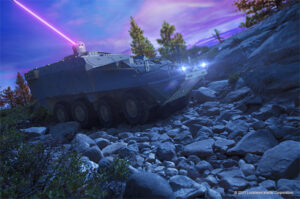Lockheed Martin [LMT] is set to begin lab testing later this year of its new directed energy system that it will offer for the Army’s expected competition to field a Stryker-mounted 50-kilowatt laser system.
Following the “first light” of the new Directed Energy Interceptor for Maneuver Short-Range Air Defense System (DEIMOS) laser in the fourth quarter of this year, company officials told reporters testing will continue through 2023 and include a field integration test at the end of next year.

“First light from the system is hugely significant because it takes, for the first time, laser modules and combines them all the way through the system,” Tyler Griffin, Lockheed Martin’s advanced product solutions business development director, said during a briefing on DEIMOS. “What we’re effectively doing in this [fourth quarter of 2022] demonstration is showcasing an end-to-end weapon system that has the performance that we’ve predicted. And that then builds the momentum for the demos throughout the FY ‘23 period of performance.”
Lockheed Martin first detailed DEIMOS a year ago, which the company is developing to meet the Army’s Directed Energy Maneuver Short-Range Air Defense (DE M-SHORAD) requirement (Defense Daily, Oct. 11 2021).
Currently, the Army’s DE M-SHORAD program is focused on a prototyping effort with Kord Technologies providing the 50-kw laser system and Raytheon Technologies [RTX] serving as the laser module integrator, with plans to plans to deliver a platoon of four laser-equipped Strykers this fall.
The Army’s Rapid Capabilities and Critical Technologies Office (RCCTO) is currently leading the prototyping effort for DE M-SHORAD, which is intended to deliver an on-the-move laser system capable of taking down unmanned aerial systems, rotary-wing aircraft and rockets, artillery and mortars, before it’s transitioned over to Army Program Executive Office for Missiles and Space for the production program of record.
“That absolutely has Lockheed Martin’s attention. And our DEIMOS 50 kilowatt-class laser brings all that ruggedization that we’ve talked about…and the tactical laser weapon is designed to be integrated into the Army’s Stryker combat vehicle,” Griffin said. “The RCCTO is doing an outstanding job of executing to their plan for acquisition of prototypes for delivery to a unit of action. And all indications we have is that the requirements that will be developed by that unit of action will facilitate competition at the end of FY ‘23.”
Amaan Sattar, Lockheed Martin’s advanced product solutions’ laser and sensor systems director, detailed the lab testing that will take place at the company’s facility in Bothell, Wash., later this year and the eventual field integration testing in 2023 at White Sands Missile Range in New Mexico.
“[Lab testing] will be really focused on the capabilities of the high energy laser itself and making sure the laser is acting as we would expect it to, reaching the power levels that we would want to and also achieving the beam quality that we need in order for it to be effective against the targets,” Sattar told reporters. “The testing that we’ll be doing in 2023 when we take it out to White Sands Missile Range is really when we’ll be integrating it into a larger system where we add a beam control, a beam director and those elements so that we can actually put the beam on a target.”
When asked if Lockheed Martin is working on integration of DEIMOS onto a Stryker, Sattar said the company is “very confident” it can do so next year.
“We’re actually already looking into that right now. We’ve been looking at that for quite some time. So we’re actually very confident that we can do it in 2023 along with some of the other critical demonstrations that we have planned,” Sattar responded.
Lockheed Martin is also leveraging lessons learned for DEIMOS from its Layered Laser Defense (LLD) capability, according to Griffin, who noted it’s an internal investment effort that successfully defeated two cruise missile surrogates “at tactically-relevant ranges” during a February demonstration.
Griffin said many of the LLD attributes are similar to the DEIMOS system architecture “such as allowing for one single operator to engage and destroy short-range air defense targets,” adding that Lockheed Martin is focused on affordability and “production readiness of a ruggedized system.”
“Those are areas that, based on the experiences we referenced previously, we believe we’ll be well-suited to deliver a compelling solution for the Army’s requirements,” Griffin said.
Lockheed Martin announced last month it has delivered a 300-kilowatt class laser capability to the Pentagon four months ahead of schedule, with the system set to support the Army’s effort to have tactical vehicle-mounted high energy laser prototypes by fiscal year 2024 (Defense Daily, Sept. 15).